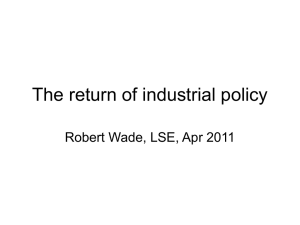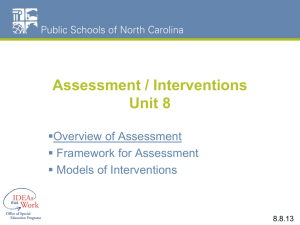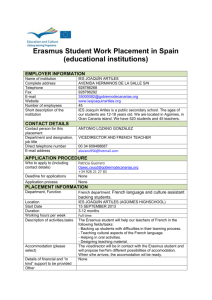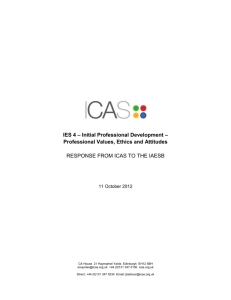Comments letter on Revised IES 8, Compagnie nationale des
advertisement
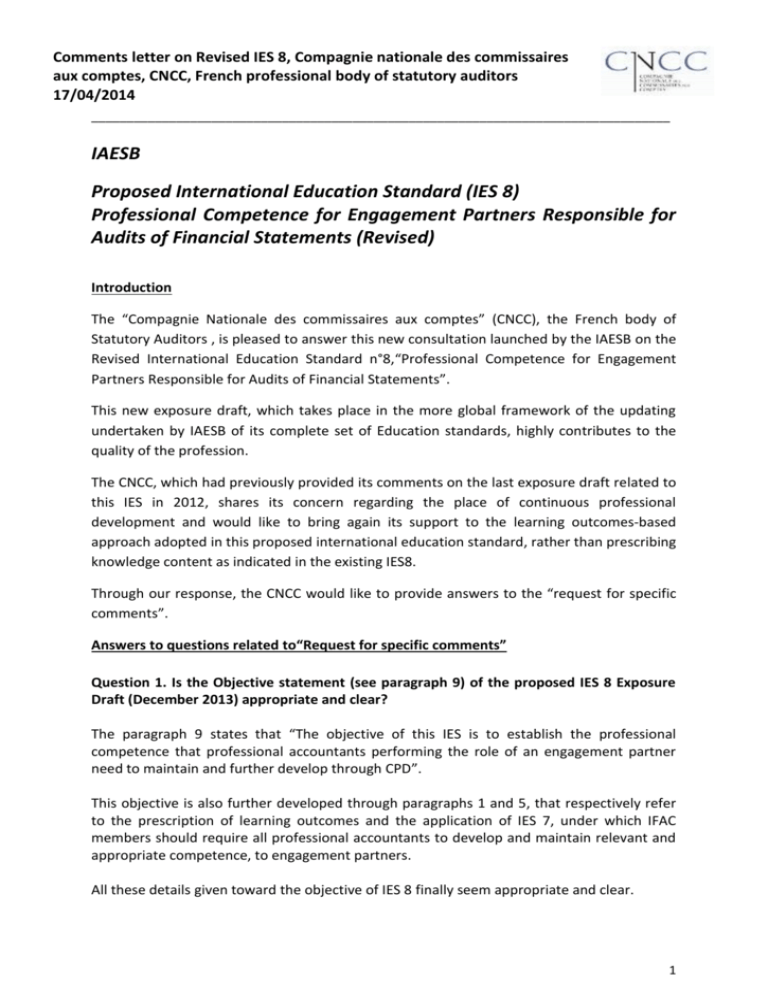
Comments letter on Revised IES 8, Compagnie nationale des commissaires aux comptes, CNCC, French professional body of statutory auditors 17/04/2014 __________________________________________________________________________________ IAESB Proposed International Education Standard (IES 8) Professional Competence for Engagement Partners Responsible for Audits of Financial Statements (Revised) Introduction The “Compagnie Nationale des commissaires aux comptes” (CNCC), the French body of Statutory Auditors , is pleased to answer this new consultation launched by the IAESB on the Revised International Education Standard n°8,“Professional Competence for Engagement Partners Responsible for Audits of Financial Statements”. This new exposure draft, which takes place in the more global framework of the updating undertaken by IAESB of its complete set of Education standards, highly contributes to the quality of the profession. The CNCC, which had previously provided its comments on the last exposure draft related to this IES in 2012, shares its concern regarding the place of continuous professional development and would like to bring again its support to the learning outcomes-based approach adopted in this proposed international education standard, rather than prescribing knowledge content as indicated in the existing IES8. Through our response, the CNCC would like to provide answers to the “request for specific comments”. Answers to questions related to“Request for specific comments” Question 1. Is the Objective statement (see paragraph 9) of the proposed IES 8 Exposure Draft (December 2013) appropriate and clear? The paragraph 9 states that “The objective of this IES is to establish the professional competence that professional accountants performing the role of an engagement partner need to maintain and further develop through CPD”. This objective is also further developed through paragraphs 1 and 5, that respectively refer to the prescription of learning outcomes and the application of IES 7, under which IFAC members should require all professional accountants to develop and maintain relevant and appropriate competence, to engagement partners. All these details given toward the objective of IES 8 finally seem appropriate and clear. 1 Comments letter on Revised IES 8, Compagnie nationale des commissaires aux comptes, CNCC, French professional body of statutory auditors 17/04/2014 __________________________________________________________________________________ Question 2. Is the Requirement (see paragraph 10) of the proposed IES 8 Exposure Draft (December 2013) appropriate and clear? This Requirement states that “IFAC member bodies shall require professional accountants performing the role of an engagement partner to undertake CPD that maintains and further develops the professional competence required for this role. Such professional competence is demonstrated by the achievement of the learning outcomes listed in Table A”. The CNCC agrees on the importance of continuous learning of a high level through professional training. On the one hand, it is no doubt that this requirement, which sounds appropriate and clear, could indeed actively contribute to reassure third parties and more globally all the stakeholders about the nature and the added value of the Statutory Auditor’s assignment. But on the other hand, it could lead to some difficulties regarding the assessment of the achievement of these learning outcomes by engagement partners. Question 3. Do you agree with the proposed learning outcomes provided in Table A? The CNCC shares the IAESB’s concern to introduce a learning outcomes approach and agrees with the Table A, which is comprehensive and clear. Question 4. Do you agree that levels of proficiency for the competence areas should not be included in Table A? The CNCC is supportive of the removal of levels of proficiency which were previously mentioned as “intermediate” and “advanced”, as they left room for interpretation and whereagainst the need of harmonisation. Questions 5. Are there any additional explanatory paragraphs needed to better explain the requirement of the proposed IES 8 Exposure Draft (December 2013)? The CNCC welcomes the IAESB’s work on definition and does not have any additional requests to add to the project. Question 6. Does figure 1 of Explanatory Material section for the proposed IES 8 Exposure Draft (December 2013) assist in understanding which stakeholders have responsibilities that impact the professional competence of engagement partners? This figure accurately and clearly summarises the paragraph 2, which details the various stakeholders and what are the relationships between them. Question 7. Are there any terms within the proposed IES 8 Exposure Draft (December 2013) which require further clarification? If so, please explain the nature of the deficiencies? No. 2 Comments letter on Revised IES 8, Compagnie nationale des commissaires aux comptes, CNCC, French professional body of statutory auditors 17/04/2014 __________________________________________________________________________________ Question 8. Do you anticipate any impact or implications for your organization, or organizations with which you are familiar, in implementing the requirement included in this proposed IES 8 Exposure Draft (December 2013)? According to the draft, audit engagement partners should be subject to a long list of detailed learning outcomes regarding technical competence, professional skills, ethical behaviour. It can be very challenging for member bodies to design appropriate programs which will cover all those detailed learning outcomes. It can be also very challenging for member bodies to design a process to monitor to what extent auditing engagement partners meet all the CPD requirements. Question 9. What topics or subject areas should Implementation guidance cover? This guidance material should demonstrate how to link competencies and inputs, as the input based approach is prevailing in a large number of jurisdictions. It would be also very useful to have some examples. 3


